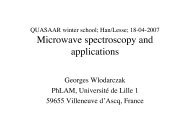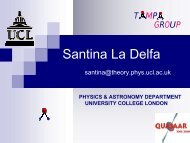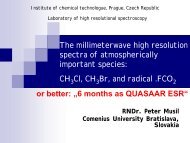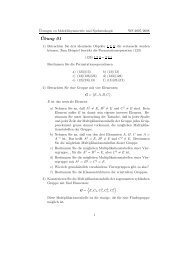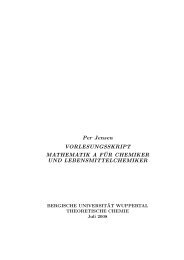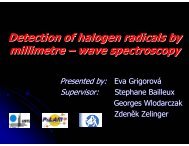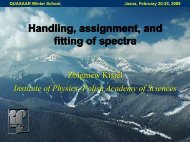Abstract book - Prof. Per Jensen, Ph.D. - Bergische Universität ...
Abstract book - Prof. Per Jensen, Ph.D. - Bergische Universität ...
Abstract book - Prof. Per Jensen, Ph.D. - Bergische Universität ...
- No tags were found...
Create successful ePaper yourself
Turn your PDF publications into a flip-book with our unique Google optimized e-Paper software.
116 Poster session, H3Rotationally-resolved High-resolution Laser Spectroscopyof the B – X Electronic Transition of NO 3 RadicalKohei Tada 1 , Shunji Kasahara 2 , Masaaki Baba 3 , Takashi Ishiwata 4 , Eizi Hirota 51 Graduate School of Science, Kobe University, Japan,e-mail address : 101s219s@stu.kobe-u.ac.jp;2 Molecular <strong>Ph</strong>otoscience Research Center, Kobe University, Japan,e-mail address : kasha@kobe-u.ac.jp;3 Graduate School of Science, Kyoto University, Japan;4 Graduate School of Information Sciences, Hiroshima City University, Japan;5 The Graduate University for Advanced Studies, Japan.Tada K.Kasahara S.Baba M.Ishiwata T.Hirota E.The nitrate radical (NO 3 ) is known as an important intermediate in the night atmosphere,thus it has been studied both experimentally and theoretically by a lot of scientists asreviewed by Wayne et al. 1 Furthermore, NO 3 is one of the good models to understandintramolecular interactions such as the Jahn-Teller effect of nonlinear polyatomicradical species. The B 2 E’ – X 2 A 2 ’ transition of NO 3 is an optical allowed transition andobserved as an intense absorption band in the visible region. Especially, the 0 – 0 bandof the NO 3 B – X transition is the most intense absorption band around 15100 cm -1 .However the high-resolution fluorescence excitation spectra of this band have beenreported by Carter et al, 2 the rotational assignment was still remained because theobserved spectra were too complicated to be analyzed.In this study, the rotationally-resolved high-resolution fluorescence excitation spectra ofthe 0 – 0 band of the NO 3 B – X transition have been observed by crossing single-modelaser beam perpendicular to a collimated molecular beam. NO 3 was generated by thepyrolysis of N 2 O 5 : N 2 O 5 → NO 3 + NO 2 . The several vibronic bands of the NO 2 A 2 B 2 –X 2 A 1 transition around 15100 cm -1 were also observed and we found the NO 2 signalsare negligibly small compare to the NO 3 signals in the observed region. The typicallinewidth of NO 3 rotational lines was about 20 MHz. The absolute wavenumbers of therotational lines were calibrated in the accuracy of 0.0001 cm -1 by the simultaneousmeasurements of both Doppler-free saturation spectra of iodine molecules and thefringe patterns of the stabilized étalon. There are more than 2000 rotational lines of NO 3in the observed region : 15070 – 15145 cm -1 , and the rotational lines have less regularity.This complicated rotational structure suggests that the B (υ = 0) level strongly interactswith the other vibronic levels. We also observed the Zeeman effects of the observedrotational lines and found that several rotational lines show the same Zeeman patterns.This fact suggests that there are several vibronic bands in the observed region. Weassigned more than 200 rotational lines based on the observed Zeeman patterns and theground state combination differences from the reported molecular constants of the X (υ= 0) level. 3 The effective molecular constants of the B (υ = 0) level were determinedfrom the rotational assignment.References[1] R. P. Wayne, I. Barnes, P. Biggs, J. P. Burrows, C. E. Canosa-Mas, J. Hjorth, G. LeBras, G. K. Moortgat, D. <strong>Per</strong>ner, G. Poulet, G. Restelli, and H. Sidebottom, Atmos.Environ. 25A, 1, 1991.[2] R. T. Carter, K. F. Schmidt, H. Bitto, and J. R. Huber, Chem. <strong>Ph</strong>ys. Lett., 257, 297,1996.[3] K. Kawaguchi, T. Ishiwata, E. Hirota, and I. Tanaka, Chem. <strong>Ph</strong>ys., 231, 193, 1998.




